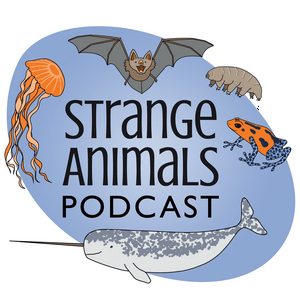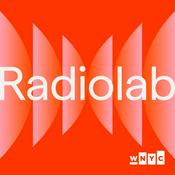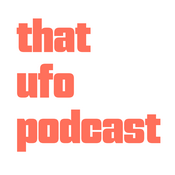332 episodes

Episode 464: Farmyard Animals
22/12/2025 | 9 mins.
Thanks to Emily, Jo, and Alexandra for their suggestions this week! Further reading: Highland Cattle Society Mongolian Sheep The Donkey Sanctuary The Highland cow is so cute (picture taken from the first site linked above): Some fat-tailed sheep (picture taken from the sheep article linked above): Donkeys: A happy donkey and a happy person (photo taken from the Donkey Sanctuary’s site, linked above): Show transcript: Welcome to Strange Animals Podcast. I’m your host, Kate Shaw. After last week’s giant fish episode, this week we’re going to have a shorter episode of animals you’ve probably seen, especially if you live in the countryside. But first, I forgot to credit two people from last week’s episode, Dylan and Emily, who both wanted to hear about mudskippers along with Arthur! I had so many names I missed some. This week we’ll talk about some domestic mammals, suggested by Alexandra, Jo, and Emily. Let’s start with Emily’s suggestion, the Highland cow. Cows are classified in the family Bovidae, which includes not just the domestic cow and its relations but goats, sheep, antelopes, and many other animals with cloven hooves who chew the cud as part of the digestive process–but not deer or giraffes, and not the pronghorn even though people call it an antelope. It is confusing. Many bovids have horns, usually only two but sometimes four or even six, and those horns are never branched. Sometimes only the male has horns, sometimes both the male and female. Bovids don’t have incisors in the front of the upper jaw, only in the lower jaw. Instead, a bovid has a tough dental pad that helps it grab plants. The Highland cow is a breed of domestic cow that originated in Scotland, although it’s now popular in many other places too. It’s a tough animal with a long outer coat of fur and a short, fuzzy undercoat that helps it survive harsh winters. Most are reddish-brown, but some are black, silvery-white, dun, or other shades. It has long, wide horns and its long fur usually falls over its face, which protects its eyes and also looks incredibly cute. Not only can the Highland cow thrive on pasture that’s considered poor, meaning the plants aren’t as nutritious, it’s also disease resistant, even-tempered, and intelligent. It’s a compact, relatively small cow, but it’s not a miniature cow. Like, you can’t pick it up like a dog, although you could probably hug one if the farmer says it’s okay. A bull can stand about 5 feet tall at the shoulder, or 1.5 meters, while cows are smaller overall. The Highland cow is raised for its meat, which is naturally lean and delicious. But because they also happen to be small for cows, and so even-tempered, and so cute, many small farms and petting zoos keep a few just as pets. Since the Highland cow likes eating plants that other cow breeds won’t touch, it’s also helpful for clearing overgrown land. Next, Alexandra wanted to learn more about the fat-tailed sheep, another bovid. The sheep is one of the oldest domesticated animals in the world, with some experts estimating that it was first domesticated at least 11,000 years ago and possibly over 13,000 years ago, around Asia and the Middle East. Sheep are especially useful to humans because not only can you eat them, they produce wool. Wool has incredible insulating properties, as you’ll know if you’ve ever worn a wool sweater in the snow. Even if it gets wet, you stay nice and warm. Even better, you don’t have to kill the sheep to get the wool. The sheep just gets a haircut every year to cut its wool short. Wild sheep don’t grow a lot of wool, though. They mostly have hair like goats. Humans didn’t start selecting for domestic sheep that produced wool until around 8,000 years ago. The fat-tailed sheep isn’t a single breed but a type of sheep, most common in central Asia, northern Africa, and the Middle East. It’s adapted for life in arid conditions, where there isn’t a lot of water. The fat deposits on both sides of the tail act like a camel’s hump, allowing the animal to absorb the stored fat if it can’t find enough food and water. The fat-tailed sheep can have a really huge tail, so big it can make up almost a third of its body weight. Because the fat mostly collects on either side of the tail bones, the tail’s shape has two lobes, which makes the sheep look like it has an extra butt on its butt. In some breeds, the tail gets wider as the fat deposits grow, while in other breeds, the tail just gets longer, sometimes so long it actually brushes the ground. The tail fat helps the sheep, but it’s also considered a delicacy to people. Wherever the fat-tailed sheep is raised, there are special recipes to cook the tail. Many breeds of fat-tailed sheep also produce long, coarse wool that’s used to make carpets and felt. We’ll finish with Jo’s suggestion, the domestic donkey. Donkeys are equids, and instead of cloven hooves like bovids, they have solid hooves. They’re closely related to horses and zebras, and more distantly related to rhinoceroses and tapirs. The domestic donkey is descended from the African wild ass. Researchers estimate it was domesticated around five to seven thousand years ago by the ancient nomadic peoples of Nubia in Africa, and quickly spread throughout the Middle East and into southern Asia and Europe. The domestic donkey is a strong, sturdy animal that’s usually fairly small. One of the biggest breeds is the American Mammoth Jackstock, and another is the French Baudet du Poitou, which has long fur. Both breeds can be as big as a horse. Big donkey breeds like these were mostly developed to cross with horses, to produce even larger, stronger mules. Mules are hybrid animals and are infertile, but they’re very strong. The donkey is usually gray or brown and has long ears. Most have a darker stripe down the spine, called an eel stripe, and another stripe across the shoulders. Many have a lighter-colored nose, belly, and legs. The donkey’s mane is short and stands upright. The donkey’s small size and big strength has made it a popular working animal throughout the world. It can carry loads, can be ridden, and can pull carts and plows. It’s famously tough and can be stubborn if it doesn’t feel like it’s being treated well, and it can even be dangerous when it kicks and bites. Sometimes farmers keep donkeys with their sheep or other animals, because the donkey will look out for danger and warn the herd by braying if it sees a predator. If the predator gets too close, the donkey will attack it instead of running away. In many places in the world, the donkey is an important work animal even today. Not everyone is lucky enough to afford a tractor or truck, so donkeys do the same work for people that they’ve done for thousands of years. The problem is that when a donkey gets old or is injured, and can’t work anymore, sometimes they’re killed for meat or just abandoned. Luckily there are donkey rescues who do their best to help as many donkeys as they can, especially the Donkey Sanctuary. The Donkey Sanctuary started in England in 1969, but it now has sanctuaries throughout Europe, and it runs programs that offer free veterinary care and education about donkeys for people in many parts of the world. One important thing the Donkey Sanctuary does, and other donkey rescues do too, is give a home to elderly donkeys who can’t work anymore. It’s only fair that a hard-working donkey gets to retire and have a peaceful old age. You can find Strange Animals Podcast at strangeanimalspodcast.blubrry.net. That’s blueberry without any E’s. If you have questions, comments, corrections, or suggestions, email us at [email protected]. Thanks for listening!

Episode 463: The Big Fish Episode
15/12/2025 | 20 mins.
It’s an episode just absolutely full of fish! Thanks to Arthur, Yuzu, Jayson, Kabir, Nora, Siya, Joel, Elizabeth, Mac, Ryder, Alyx, Dean, and Riley for their suggestions this week! Further reading: Study uncovers mechanics of machete-like ‘tail-whipping’ in thresher sharks Business end of a sawfish: Giant freshwater stingray! The frilled shark looks like an eel: The frilled shark’s teeth: The thresher shark and its whip-like tail [photo by Thomas Alexander – Own work, CC BY-SA 4.0, https://commons.wikimedia.org/w/index.php?curid=50280277]: The Halmahera epaulette shark, looking a little bit like a long skinny koi fish [photo by Mark Erdmann, California Academy of Sciences, Attribution, https://commons.wikimedia.org/w/index.php?curid=30260864]: A mudskipper, which is a fish even though it kind of looks like a weird frog [photo by Heinonlein – Own work, CC BY-SA 4.0, https://commons.wikimedia.org/w/index.php?curid=44502355]: The red-lipped batfish wants a big kiss: The male blue groper is very blue [photo by Andrew Harvey, some rights reserved (CC BY) – https://www.inaturalist.org/photos/62196538, CC BY 4.0, https://commons.wikimedia.org/w/index.php?curid=157789928]: The giant oarfish is very long: Show transcript: Welcome to Strange Animals Podcast. I’m your host, Kate Shaw. This week we have a big fish episode! I mean, it’s a big episode about a lot of different fish, not necessarily fish that are big—although some of them sure are! Thanks to Arthur, Yuzu, Jayson, Kabir, Nora, Siya, Joel, Elizabeth, Mac, Ryder, Alyx, Dean, and Riley. I told you this is a big fish episode. Let’s jump right in with a fish suggested by Jayson, the sawfish. There are five species of sawfish alive today. The smallest can still grow over 10 feet long, or 3 meters, while the biggest species can grow over 20 feet long, or 6 meters. The largest sawfish ever reliably measured was 24 feet long, or 7.3 meters. The sawfish lives mostly in warm, shallow ocean waters, usually where the bottom is muddy or sandy. It can also tolerate brackish and even freshwater, and will sometimes swim into rivers and live there just fine. The sawfish is a type of ray, and rays are most closely related to sharks. Like sharks, rays have an internal skeleton made of cartilage instead of bone, but they also have bony teeth. You can definitely see the similarity between sharks and sawfish in the body shape, although the sawfish is flattened underneath, which allows it to lie on the ocean floor. There’s also another detail that helps you tell a sawfish from most sharks: the rostrum, or snout. It’s surprisingly long and studded with teeth on both sides, which makes it look like a saw. The teeth on the sawfish’s saw are actual teeth. They’re called rostral teeth and the rostrum itself is part of the skull, not a beak or a mouth. It’s covered in skin just like the rest of the body. The sawfish’s mouth is located underneath the body quite a bit back from the rostrum’s base, and the mouth contains a lot of ordinary teeth that aren’t very sharp. Since the sawfish has plenty of teeth in its mouth, you may be wondering how and why it also has extra teeth on both sides of its saw. It’s because the rostral teeth evolved from dermal denticles. Dermal denticles look like scales but they’re literally teeth, they’re just not used for eating. Sharks have them too, along with some other fish. In the case of the sawfish, the rostral teeth grow much larger than an ordinary dermal denticle, and stick out sideways. Both the rostrum and the head are packed with electroreceptors that allow the sawfish to sense tiny electrical charges that animals emit as they move. This might mean a school of fish swimming through muddy water, or it might mean a crustacean hiding in the sand. The sawfish sometimes uses its rostrum to dig prey out of the sand, but it also uses it to slash at fish or other animals. Then the sawfish can either grab the injured or dead animal with its mouth or pin it to the sea floor with its rostrum to maneuver it into its mouth. Its mouth is relatively small and it prefers to swallow its food whole, head-first, so it can only eat fish that are smaller than its mouth. That’s also why it doesn’t want to eat people. Its mouth is too small. Yuzu wanted to learn about another shark relation, the giant freshwater stingray, which lives in rivers in southeast Asia. It’s dark gray-brown on its back and white underneath, and it has a little pointy nose at the front of its disc. It also has dermal denticles on its back. The giant freshwater stingray has a rounded, flattened body, and it’s really big. A big female can grow over 7 feet across, or 2.2 meters. Its tail is long and thin with the largest spine of any stingray known, up to 15 inches long, or 38 cm. Its tail is so long that if you measure the giant freshwater stingray by length including its tail, instead of by width of its disc, it can be as much as 16 feet long, or about 5 meters. Some researchers think there might be individuals out there much larger than any ever measured, possibly up to 16 feet wide. The length and thinness of the tail gives the ray its other common name, the giant freshwater whipray, because its tail looks like a whip. While we’re talking about shark relations, let’s go ahead and talk about a few actual sharks. Kabir wanted to learn about the frilled shark, which looks and acts more like an eel than a shark. A big female can grow up to 6 and a half feet long, or 2 meters. Males are a little shorter on average. The frilled shark has the same anatomy found in ancient sharks from the fossil record, dating back at least 95 million years. It’s found a body type that works for it. The frilled shark lives on the continental shelf in many parts of the world, and while it technically lives near the sea floor, at night it migrates closer to the ocean surface to find fish, squid and other cephalopods, and other food. There are two species known, with the southern African frilled shark only discovered in 2009. The frilled shark is dark brown or gray, and its jaws are long and contain clusters of teeth in little rows. Each tooth has three sharp points, and there are 300 teeth, so a frilled shark has 900 points in its mouth. The points are so sharp that scientists examining dead sharks have gotten cut on the teeth, which would be really embarrassing if you’re a shark expert that was bitten by a dead shark. The frilled shark can open its jaws extremely wide to swallow fish and other animals that are up to about half the size of the shark itself. It even eats other sharks. Next, Joel wanted to learn about the thresher shark. It’s a truly big fish that can grow up to 20 feet long, or over 6 meters. It’s a fast, slender shark with a tail fin that can be as long as its body. It eats a lot of other animals, including birds and crustaceans, but it specializes in hunting fish that travel in schools, like tuna, sardines, and mackerel. It uses its incredibly long tail as a whip, slapping a fish to stun it so the shark can eat it. When it whips its tail, its body flexes so that its head points downward in the water with the tail snapping forward over it. A 2024 study determined that the thresher shark’s vertebral column is fortified to allow it to work like a catapult. The thresher shark can also use its long tail to help it leap out of the water completely, although scientists don’t know why it wants to do that. There are three species of thresher shark known to science, but in 1995 a genetic analysis revealed the possible presence of a fourth species. Scientists think it lives in the eastern Pacific and may look similar to the bigeye thresher, enough that it gets misidentified as that species when it’s seen. The three known species of thresher shark are hard to tell apart at a distance as it is. And for our last shark, Siya asked about the Halmahera epaulette shark. It’s light brown with darker and lighter spots, and is a slender shark that can grow a little over 2 feet long, or 68 cm. It lives around Indonesia, and it might live in other places too. We don’t know yet, because it was only discovered in 2013 and only two specimens have ever been found. Epaulette sharks are also called walking sharks, because they use their fins to walk along the sea floor and explore crevices in rocks. Some species can even walk short distances on land to enter tidal pools and other places where they can find food. They live in warm, shallow water, usually near reefs or islands, and they eat whatever small animals they can find. There are nine species known, but there are undoubtedly more than haven’t yet been discovered by science. You might think this is strange for a shark that can walk on land, but walking sharks are nocturnal and not very big, so it’s easy to miss them when they’re out and about. That brings us to Arthur’s suggestion, the mudskipper. The mudskipper also uses its fins to walk. Its pectoral fins are muscular and allow it to climb out of the water and onto land, climb into low branches, and even jump. Its pectoral fins look like little arms, complete with an elbow. The elbow is actually a joint between the actual fins and the radial bones, which in most fish are hidden within the body but which stick out of the mudskipper’s sides a short distance. This helps it move around on land more easily. Its pelvic fins are also shaped in such a way that they act as little suction cups on land. The mudskipper is so good at living on land that it’s actually considered semi-aquatic. It lives in mudflats, mangrove swamps, the mouths of rivers where they empty into the ocean, and along the coast, although it prefers water that’s less salty than the ocean but more salty than ordinary freshwater. It only lives in tropical and subtropical areas because it needs high humidity to absorb oxygen through its skin and the lining of its mouth and throat. The mudskipper is a fish, but it looks an awful lot like a frog in some ways, due to convergent evolution. It has a wide mouth and froglike eyes at the top of its head and will often float just under the water with its eyes above water, looking for insects it can catch. The largest species grows about a foot long, or 30 cm, and while it has some scales, its body is coated with a layer of mucus to help it retain moisture. It spends most of the day on land, hunting for insects and other small animals. Not only can it absorb oxygen through its skin, it keeps water in its gill chambers to keep the gills wet too. It even has a little dimple under its eye that holds water, that helps keep its eyes moist. The mudskipper also takes a big mouthful of water with it when it climbs on land, but not to breathe. It uses the water to hunt with. When it encounters an insect or other small animal on land, it carefully rotates its mouth–yes, it can rotate its mouth, which has led to me trying to rotate my mouth, something humans can’t actually do–so that its mouth is just above the animal. Then it spits out the mouthful of water onto the insect and immediately sucks the water back into its mouth, carrying the insect with it. When it catches an animal underwater, it opens its big mouth quickly, causing suction that sucks the animal right into its mouth. It also has sharp teeth, so when an animal is in its mouth, it’s not getting out again. Alyx, Dean, and Riley suggested we talk about the red-lipped batfish, a type of anglerfish only found around the Galapagos Islands in the Pacific Ocean. It lives on the ocean floor where the water is fairly shallow, and it grows about 8 inches long, or 20 cm. It’s usually a mottled brown, green, or grey with a white stomach, but its mouth is bright red. It looks like it’s wearing lipstick. It eats fish and other small animals, which it attracts using a lure on its head, a highly modified dorsal fin called an illicium. The weirdest thing about the red-lipped batfish is actually its fins. It prefers to walk on the bottom of the ocean instead of swim, and it has modified pectoral fins called pseudolegs. The pseudolegs make it look a little bit like a weird frog with lipstick. Researchers think the red lips may be a way to attract potential mates, presumably ones who are hoping for a big smooch. At this rate I’m wondering if there are any fish that don’t walk on their fins. Next, Mac wanted to learn about a fish called the payara. The problem is, there are two fish with that name, so let’s learn about them both! The first payara is a pretty, silvery fish with a couple of small dark spots on its body. It’s found in the Amazon basin in South America and can grow at least 1 foot 8 inches long, or 51 cm. It’s sometimes kept in large aquariums, and is sometimes called the vampire tetra or the vampire fish because it has a pair of long fangs that it uses to stab other fish with before eating them. Its fangs stick up from its lower jaw, though, so if it’s a vampire fish, it’s an upside-down vampire. As for the other payara, it’s related to the first kind and is also found in South America, but it’s even larger. It can grow a little over 3 feet long, or 3.3 meters. Its teeth are also large and sharp, including two big fangs sticking up from its lower jaw. In a big individual, its fangs may be 4 inches long, or 10 cm. This is not a fish you want to get bitten by! You are probably not in any danger of being bitten by this payara, though, unless you happen to spend a lot of your time swimming along the bottom of rivers in the Amazon. Quite a while ago, Ryder suggested we learn about the pipe cichlid. I tried to find more about it and I think it’s actually a fish called the pike cichlid. Pike cichlids are popular freshwater aquarium fish that are native to tropical and subtropical parts of eastern South America, and there are about 45 species known so far. They’re typically quite small, with most species only growing a few inches long, or around 8 cm, although some species are more than twice that length. The pike part of their name comes from their shape, like a teeny-tiny pike, a predatory fish that can grow up to 5 feet long, or 1.5 meters. Pike and pike cichlids aren’t related, but pike cichlids are predatory. It’s just that instead of eating other fish, ducks, frogs, and even reptiles and mammals that end up in the water, the pike cichlid mostly eats insects. Elizabeth wanted to learn about the blue groper, a fish found around Australia and nowhere else in the world. It lives around reefs and rocky areas near the coast, where it can find plenty of starfish, urchins, crustaceans, and other small animals to eat. It can grow almost six feet long, or 1.75 meters, and its teeth are peg-shaped to help it pick mollusks and other animals off of rocks before crushing them. It’s called the blue groper because males are a beautiful blue color, while females are brown or reddish-brown and young fish are green. All young blue gropers are female, and as they grow up some change to become males while most remain females. The fish grow very slowly and can live to be at least 70 years old, so the fish don’t even reach maturity until they’re 15 or 20 years old. When a fish is around 30 or 35 years old, it will change gender again, this time becoming a male. But if the male of a group dies, the group’s dominant female will change into a male and turn blue. This is common in the family of fish that the blue groper belongs to, Labridae, also called wrasses. Let’s finish with a suggestion from Nora, the oarfish. The giant oarfish and Russell’s oarfish can both grow at least 26 feet long, or 8 meters, and possibly much longer. Most of its length is tail, which often shows damage from being bitten. Since its organs are all close to the front of its body, and it doesn’t need its tail for swimming, if a predator takes a bite out of its tail, the fish is going to be fine. The oarfish can even detach pieces of its tail if it needs to, the same way some lizards can, to distract a potential predator. Like those lizards, the tail doesn’t grow back. The oarfish is silvery in color with a red crest on its head and a mane-like fin down its back, although it’s actually an elongated dorsal fin. It has extremely long pelvic fins too. The giant oarfish has a short, blunt snout and no teeth because it filters krill and other tiny animals from the water. It doesn’t have scales. Instead, its skin is soft with a delicate layer called ganoine that gives it a shimmery, almost metallic appearance. The long filaments of the crest on its head and its pelvic fins are also delicate. But although it’s long and slender like an eel, it actually swims vertically with its head pointing up and its tail down. We’re not sure why, although one theory is that this minimizes its profile to predators looking up from below. It can swim quickly straight up and down to avoid predators that mostly just swim forward. We know so little about the oarfish, and what we know is so strange, that it’s the next best thing to a sea serpent. The first living giant oarfish was only filmed in 2001. Most oarfish are only seen when they’re dead or dying. It seems to live throughout the world’s oceans, except for the Arctic and Antarctic, and is a deep-sea fish but may migrate closer to the surface at night to find more food. A Japanese legend says the oarfish predicts earthquakes. If an oarfish is seen near the surface or washes up on a beach, an earthquake is supposed to be imminent. That seems to be a coincidence, though. The oarfish looks like a sea serpent, and some people think it might have given rise to some sea serpent sightings. This may or may not be the case, but it’s certainly a mysterious fish. You can find Strange Animals Podcast at strangeanimalspodcast.blubrry.net. That’s blueberry without any E’s. If you have questions, comments, corrections, or suggestions, email us at [email protected]. Thanks for listening!

Episode 462: Cryptic Coloration
08/12/2025 | 17 mins.
Thanks to Måns, Sam, Owen and Askel for this week’s suggestions! Further reading: Shingleback Lizard What controls the colour of the common mānuka stick insect? The mossy leaf-tailed gecko has skin flaps that hide its shadow. There’s a lizard in this photo, I swear! [photo by Charles J. Sharp – Own work, CC BY-SA 4.0, https://commons.wikimedia.org/w/index.php?curid=92125100]: A shingleback lizard, pretending it has two heads: The beautiful wood nymph is a beautiful moth but also it looks like a bird poop: The Indian stick insect (photo by Ryan K Perry, found on this page): The buff tip moth mimics a broken-off stick. This person has a whole handful of them: A cuttlefish can change colors quickly [photo by Σ64 – Own work, CC BY 4.0, https://commons.wikimedia.org/w/index.php?curid=77733806]: Show transcript: Welcome to Strange Animals Podcast. I’m your host, Kate Shaw. This week we’re going to talk about a few types of camouflage, a suggestion by Måns, and we’ll also talk about some camouflaged animals suggested by Sam, Owen and Aksel, Dylan, and Nina. There are lots of types of camouflage, not all of it visual in nature. Back in episode 191 we talked about some toxic moths that generate high-pitched clicks that bats hear, recognize, and avoid. Naturally, some non-toxic moths also generate the same sounds to mimic the toxic moths. Måns specifically suggested cryptic coloration, also called crypsis. It’s a type of camouflage that allows an animal to blend into their surroundings, which can involve multiple methods. Some animals have cryptic coloration mainly along the edges of the body, to defeat a skill many predators use called edge detection. A lot of amphibians and reptiles have patches surrounded by an outline, with dark patches having a darker outline and light patches having a lighter outline. This acts as disruptive camouflage, hiding the outline of an animal’s body as it moves around. Some animals take this camouflage even further, with a way to hide their own shadow. This is the case with the mossy leaf-tailed gecko, which is native to the forests of eastern Madagascar. It can grow up to 8 inches long, or 20 cm, not counting its tail, and it’s nocturnal. Its tail is flat and broad, sort of shaped like a leaf, but it doesn’t disguise itself as a leaf. The mossy leaf-tailed gecko has a complicated gray and brown pattern that looks like tree bark, and it can change its coloration a little bit to help it blend in even more. At night it’s well hidden in tree branches as it climbs around looking for insects, but in the day it needs to hide really well to avoid becoming some other animal’s snack while it’s sleeping. It does this by finding a comfortable branch and flattening its body and tail against it so that it just looks like another part of the branch. But to make it even more hidden, it has a flap of skin along its sides that wraps even farther around the branch. Not only do these skin flaps hide its edges, it hides its shadow, since the flaps are really flat and there’s no curved edge of a lizard belly pressed against a branch that a predator might notice. The most common kind of cryptic coloration is called countershading, and it’s so common that you might not even have noticed it although you see it almost every time you see a fish, amphibian, reptile, and many birds and mammals. Countershading is an animal that’s darker on top and lighter underneath, like a brown mouse with a white belly. It’s even found in some insects and other invertebrates. Countershading is another way to hide a shadow. If a dolphin, for instance, was gray all over, its underside would look darker because of shadows, since sunlight shines down from the sky and makes shadows underneath the body. That would make its body shape look rounder, meaning it stands out more and a predator would notice it more easily. But most dolphins are pale gray or even white underneath. There’s still a shadow, but it’s no longer darker than the rest of the body. The lighter colored underside makes the shadow paler, and as a result, from a distance the dolphin looks almost the same shade all over, which makes it appear flat and the edges of its body harder to see. We even know that some dinosaurs were countershaded, with lighter colored bellies. Countershading is so common in animals that it’s almost impossible to pick one example. Dylan suggested we learn about the shingleback lizard, an amazing animal found in many parts of Australia. It’s also called the stumpy-tailed lizard, the bobtail lizard, or the two-headed lizard. All three of those names refer to the animal’s tail, which is short and fat and actually looks like a second head. This is an example of automimicry, similar to animals that have markings that look like eyes. The lizard is brown with darker and lighter speckles and it sometimes has yellow spots too. Its belly is pale with dark spots. Its scales are large and overlap each other, and its eyes are tiny, like little black beads. It grows about a foot long, or 30 cm. The shingleback lives in arid and desert areas, and its tough skin and overlapping scales help reduce water loss. It eats snails, insects, flowers, and other small animals and plants. When threatened, it will open its mouth wide and stick out its large, dark blue tongue. It is an impressively blue, impressively big tongue, and the inside of the shingleback’s mouth is bright pink, so the lizard has a chance to escape while its predator is startled and wondering if the lizard is dangerous. The shingleback can give a painful bite, although it’s not venomous. The shingleback mates for life, and the female gives birth to two or three live young every year instead of laying eggs. In many reptiles that give birth to live young, the eggs basically remain in the mother’s body until they hatch, and then she gives birth. But in the shingleback’s case, her babies develop in placentas in a process very similar in many ways to placental mammals. The babies eat the placenta after they’re born, giving them a quick first meal, and they’re born ready to take care of themselves. Sam suggested we talk about animals that can be confused with inanimate objects, which is a type of camouflage referred to as mimicry. Mimicry of all kinds is a really common type of camouflage, like all those harmless insects that have yellow and black stripes to mimic bees and wasps that can sting. My favorite inanimate object mimic is a moth we talked about in episode 191, the beautiful wood nymph of eastern North America. It has a wingspan of 1.8 inches, or 4.6 cm, and it is indeed a beautiful little moth. Its front wings are mostly white with brown along the edges and a few brown and yellow spots, while the rear wings are a soft yellow-brown with a narrow brown edge. It has furry legs that are white with black tips. But when the moth folds its wings to rest, suddenly those pretty markings make it look exactly like a bird dropping. It even stretches out its front legs so they resemble a little splatter on the edge of the poop. If you think about it, it makes sense that a tiny animal like an insect would want to resemble something common in its environment that’s also not eaten by very many other animals. For instance, a stick. Owen and Aksel wanted to learn more about the walking stick, since it’s been a long time since we talked about it, episode 93. Walking stick insects are also called stick insects or phasmids. When I was a kid I was terrified of the whole idea of a stick insect, although I don’t know why. I think I thought one day I’d climb a tree and discover that some of those sticks were not actually part of the tree. I guess I spent a lot of time climbing trees, but I never actually saw a walking stick insect. Maybe that’s because they were so well camouflaged that I thought they were sticks! Walking sticks live in trees and bushes, naturally, especially in warm areas, but they’re found on every continent except Antarctica. They’re long, thin insects with long, thin legs and they really do look like sticks. Some are green, some are brown or gray, and many have little patterns, projections, and ridges that make them look even more like real sticks. They’re closely related to another type of phasmid called a leaf insect, which as you may have already guessed, mimics a leaf. All phasmids eat leaves and other plant material and most are nocturnal. Some phasmids can even change colors to help blend in with their background. The Indian stick insect, which is indeed found in southern India although it’s been introduced in many other parts of the world and is considered invasive in some places, grows up to about 4 inches long, or 10 cm. It’s usually brown, but it can change its color in response to light levels by moving pigment granules in its cuticle that absorb and scatter light. The Indian stick insect has many other ways to hide in plain sight. If it feels threatened, it will stretch out with its rear legs folded flat against its body and its front pair of legs stretched forward to make it look even longer. It will stay perfectly stiff even if someone picks it up, but if it thinks it’s in danger, it will spread its front legs to show a patch of red at the base of the legs. This can startle or frighten a potential predator long enough to let the stick insect get away. One interesting thing about the Indian stick insect is that almost all individuals are females. Females don’t need to mate with a male to reproduce. The female’s babies are little clones of herself, and she drops an egg every so often onto the ground. It looks like a tiny seed, and ants think it’s a seed and will collect it and take it back to the nest to be stored for later. The egg is then protected until it hatches, when the larval insect leaves the ant nest and finds a tree or bush to hide in. The buff tip moth also looks like a twig or branch when its wings are folded, but not in the same way the walking stick insect does. It looks like a broken-off branch instead. It’s a fairly large moth with a wingspan more than 2 and a half inches across, or 7 cm, and its wings are mostly gray with a rounded buff patch at the end. The end of its abdomen is buff too, so that it looks like the inside part of a tree branch, that’s paler than the bark. It lives throughout much of Europe and Asia, and different populations look slightly different because they’ve evolved to resemble the branches of different species of tree. Let’s finish with Nina’s suggestion, about an animal that can change colors really fast to blend in with its background. That’s the cuttlefish, and Nina wanted to know how it changes colors so fast, and while we’re at it, why octopuses are so flexible. The cuttlefish is a cephalopod, closely related to octopuses and squid, but is quite small in comparison. It has eight arms and two feeding tentacles, just like the squid, but its arms are really small in comparison to its mantle. There are over 100 species known so far, most of which are small enough to fit in the palm of your hand. But unlike the squid or the octopus, the cuttlefish has an internal structure called the cuttlebone. It’s not a bone at all but a modified shell, which is your reminder that cephalopods are mollusks and are distantly related to clams, snails, and many other animals that have shells. The cuttlebone helps the cuttlefish stay buoyant without effort, and it also incidentally makes the body a little more structured than its squid and octopus cousins. Octopuses are flexible because they have no bones. Basically the only hard structure in an octopus is its beak. A cephalopod’s mouth is in the middle of its arms, so it’s usually hidden from view. Way back in episode 142 we talked about how octopus muscles work, so let’s revisit that briefly. In animals with bones, muscles are attached to the bones. But octopuses don’t have bones. The octopus’s muscles are structured differently than muscles in animals with bones. Our muscles are made up of fibers that contract in one direction. Let’s say you pick up something heavy. To do so, you contract the fibers in some muscles to shorten them, which makes the bone they’re attached to move. Then, when you push a heavy door closed, you contract other muscles and at the same time you relax the muscles you used to pick up something heavy. This pulls the arm bone in the other direction. But in the octopus, the fibers in its muscles run in three directions. When one set of fibers contracts, the other two tighten against each other and form a hard surface for the contracted fibers to move. So they’re muscles that also sort of act like bones. It’s called a muscular hydrostat, and it actually can result in muscle movements much more precise than muscle movements where a bone is involved. So, if you combine the octopus’s strong, precise muscle movements with its general lack of hard structures, you get a very flexible animal. Basically an octopus can squish itself through extremely small openings, as long as its beak will fit through. This can make it really hard to keep an octopus in captivity, because in addition to being flexible and squishy, the octopus is also really intelligent. It can survive for short periods of time out of the water, and it can figure out how to open its enclosure and get out to explore, or just escape. But, back to the cuttlefish, which is small and needs to hide from predators. Like other cephalopods, the cuttlefish can change color and pattern in less than a second, and can even change the texture of its skin if it wants to look bumpy like the rocks around it. Cephalopods have specialized cells called chromatophores in their skin. A chromatophore consists of a sac filled with pigment and a nerve, and each chromatophore is surrounded by tiny muscles. When a cuttlefish wants to change colors, its nervous system activates the tiny muscles around the correct chromatophores. That is, some chromatophores contain yellow pigment, some contain red or brown. Because the color change is controlled by the nervous system and muscles, it happens incredibly quickly, in just milliseconds. But that’s not all, because the cuttlefish also has other cells called iridophores and leucophores. Iridophores are layers of extremely thin cells that can reflect light of certain wavelengths, which results in iridescent patches of color on the skin. While the cuttlefish can control these reflections, it takes a little longer, several seconds or sometimes several minutes. Like other cephalopods, the cuttlefish uses its ability to change color and pattern in order to hide from predators. It also uses these abilities to communicate with other cuttlefish, because it’s a social animal. It will also sometimes frighten potential predators away with a bright, sudden display of color changing. The most amazing thing of all is that cuttlefish can’t see colors. They have no color receptors in their eyes. But they accurately change color to match their background, even though they can’t see the color, and they can even do so if it’s almost completely dark. While scientists have some theories as to how the cuttlefish manages this, we don’t yet know how they do it for sure. So it is still a mystery! You can find Strange Animals Podcast at strangeanimalspodcast.blubrry.net. That’s blueberry without any E’s. If you have questions, comments, corrections, or suggestions, email us at [email protected]. Thanks for listening!

Episode 461: Therizinosaurus and Its CLAWS
01/12/2025 | 7 mins.
Further reading: Study: Giant Therizinosaurs Used Their Meter-Long, Sickle-Like Claws for Display Show transcript: Welcome to Strange Animals Podcast. I’m your host, Kate Shaw. I am delighted to report that Therizinosaurus lived in what is now Mongolia in Central Asia, in the Gobi Desert. 70 million years ago, the land wasn’t a desert at all but a forest with multiple rivers and streams flowing through it. Lots of other dinosaurs and birds lived in the area, including a tyrannosaurid called Tarbosaurus that was probably the only predator big enough to kill Therizinosaurus. When the first Therizinosaurus fossils were discovered in the 1950s, they were initially thought to belong to a type of giant turtle. Later it was reclassified as a sauropod relation, not a turtle. These days, we know for sure it’s not a turtle and we’re pretty sure it’s not anything like a sauropod. The Therizinosaurus fossils found so far are incomplete. All we have are some ribs, one hind foot, and mostly complete arms and hands. We don’t have any parts of the skull or any vertebrae, so paleontologists still have a lot of questions about what Therizinosaurus looked like and how it lived, although we have more complete specimens of some of its close relations to help scientists make good guesses. Luckily we have its hands, because its claws are enormous. Therizinosaurus had claws bigger than any other dinosaur known. Therizinosaurus was a big dinosaur overall, with an estimated length of 33 feet, or 10 meters, although until a more complete specimen is discovered we can’t know for sure how big it really was. It may have stood up to 16 feet tall, or 5 meters, and walked on its hind legs. It’s classified as a theropod these days, a group that includes famous dinosaurs like T. rex and Spinosaurus, but it wasn’t closely related to those big fast meat-eaters. Most paleontologists think Therizinosaurus ate plants, but again, we don’t know for sure since we don’t have any of its teeth to examine. Its closest relatives were herbivorous but its immediate ancestors were carnivorous. If Therizinosaurus was a plant-eater, why did it have such enormous claws? Its claws were seriously terrifying! Its arms were big and strong in general, measuring about 8 feet long, or 2.5 meters, including long, slender fingers, and the claws measured over three feet long! That’s more than a meter long. If the claws were covered with a keratin sheath, which is probable, they would have been even longer when Therizinosaurus was alive. They were relatively thin and straight with a curve at the end. There are many reasons why an animal develops big claws. Predators need claws to help grab prey or tear meat into pieces, or an animal may need big claws to help it dig or climb trees. Claws are also great for defense. Some animals use claws to grab tree branches and bend them closer to the animal’s mouth, which is something that giant ground sloths probably did, at least sometimes. The new study published in February 2023 examined the claws of Therizinosaurus and lots of other dinosaurs to learn how strong they were. The claws were 3D scanned, and then the scans were used in various models that measured the stress placed on each claw in various different activities. The study discovered that the claws of different dinosaurs were strong in different ways depending on what they were used for, which wasn’t a surprise. What was a surprise was that Therizinosaurus’s claws were weak no matter which model the scientists used. In other words, Therizinosaurus probably didn’t use its claws to fight other dinosaurs unless it just had to, because they would break too easily. It wouldn’t have dug with its claws or even used them to hook branches down closer to its mouth. As far as we can tell, its claws were basically useless. But obviously, Therizinosaurus used its claws for something or it wouldn’t have evolved to have such gigantic claws. The study concluded that the giant claws must have been for display, to attract a mate or maybe just scare off potential predators. Lots of animals have special features used to attract a mate, like a peacock’s tail. Sometimes these features serve a double purpose, like a male deer’s antlers. The size of the antlers show how healthy he is, and he also uses them to fight other males. I’m not a claw expert, but as far as I know there aren’t any other animals known that use their claws for display only. It’s possible that Therizinosaurus did use its claws for something else, we just don’t know what. It’s also possible that the study had flaws that a follow-up study will discover, and Therizinosaurus’s claws weren’t actually so weak. But for now, as far as we know, during mating season Therizinosaurus would strut around waving its super-long claws to show how amazing it was. And, let’s face it, Therizinosaurus really was amazing. Thanks for your support, and thanks for listening!

Episode 460: Blue Blobs and Graveyard Snakes
24/11/2025 | 5 mins.
Further reading: Mysterious ‘blue goo’ at the bottom of the sea stumps scientists Three new species of ground snakes discovered under graveyards and churches in Ecuador Show transcript: Welcome to Strange Animals Podcast. I’m your host, Kate Shaw. I’ve come down a cold this week, and while I’m feeling better, it is settling into my chest as usual and I’m starting to cough. Since I’m still recovering and need to be in bed instead of sitting up researching animals, and since my voice is already sounding a little rough, here’s a Patreon episode this week instead of a regular episode. I had been planning to run old Patreon episodes for a few weeks in December so I could have some time off for the holidays, and those were already scheduled, so I just moved one of those episodes up to use this week instead. This is a Patreon episode from October of 2022, where we talked about two very slightly spooky animal discoveries. We’ll start with a suggestion from my brother Richard, about a strange newly discovered creature at the bottom of the ocean. On August 30, 2022, the NOAA Ocean Exploration research team was off the coast of Puerto Rico. That’s in the Caribbean, part of the Atlantic Ocean. The expedition was mostly collecting data about the sea floor, including acoustic information and signs of climate change and habitat destruction. Since the Caribbean is an area of the ocean with high biodiversity but also high rates of fishing and trawling, the more we can learn about the animals and plants that live on the sea floor, the more we can do to help protect them. When a remotely operated vehicle dives, it sends video to a team of scientists who can watch in real time and control where the rover goes. On this particular day, the rover descended to a little over 1,300 feet deep, or around 407 meters, when the sea floor came in view. Since this area is the site of an underwater ridge, the sea floor varies by a lot, and the rover swam along filming things and taking samples of the water and so forth, sometimes as deep as about 2,000 feet, or 611 meters. The rover saw lots of interesting animals, including fish and corals of various types, even a fossilized coral reef. Then it filmed something the scientists had never seen before. It was a little blue blob sitting on the sea floor. It wasn’t moving and it wasn’t very big. It was shaped roughly like a ball but with little points or pimples all over it and a wider base like a skirt where it met the ground. And it was definitely pale blue in color. Then the rover saw more of the little blue blobs, quite a few of them in various places. The scientists think it may be a species of soft coral or possibly a type of sponge, possibly even a tunicate, which is also called a sea squirt. All these animals are invertebrates that don’t move, which matches what little we know about the blue blob. The rover wasn’t able to take a sample from one of the blue blobs, so for now we don’t have anything to study except the video. But we know where the little blue blobs are, so researchers hope to visit them again soon and learn more about them. Next, let’s return to dry land and learn about some newly discovered snakes. In fact, we’re not just on dry land, we’re way up high in the Andes Mountains in South America, specifically in some remote villages in Ecuador. A teacher named Diego Piñán moved to the town of El Chaco in 2013, and he started noticing dead snakes on the road that he didn’t recognize. He also realized that people were killing the snakes on purpose. A lot of people are afraid of snakes, so Piñán made sure to teach his students about them so they would learn that most snakes aren’t dangerous. He also kept the dead snakes he found and preserved them in alcohol so he could figure out later what species they were. But he never could figure it out. Then a scientist named Alejandro Arteaga assembled a team to study the animals found in remote areas of the Andes Mountains. When they came to Piñán’s town, they were excited to see the snakes he’d preserved, because even the snake experts on the team didn’t recognize the snakes either, although they were pretty certain they belonged to a genus of snakes called Atractus. The snakes were quite pretty, gray-brown above with a bright yellow pattern underneath. They were small and slender, completely harmless to humans and pets, and they lived underground most of the time. The team searched and discovered more of the snakes living in the area. Most Atractus snakes are shy and stay away from people, but because the town of El Chaco had grown a lot recently, the snakes had moved from their home in the forest into the local cemetery. That’s right, they were burrowing around among the crypts. Of course, the snakes don’t know they’re in a graveyard. They just know they’re in a quiet place where people don’t visit very often to disturb them. The team eventually found three new species of snake in different towns, all three described in September 2022. One species was living in the cemetery, another was in a schoolyard, and another was living near a church. Still. Graveyard snakes. Thanks for your support, and thanks for listening!
More Science podcasts
Trending Science podcasts
About Strange Animals Podcast
Listen to Strange Animals Podcast, Radiolab and many other podcasts from around the world with the radio.net app

Get the free radio.net app
- Stations and podcasts to bookmark
- Stream via Wi-Fi or Bluetooth
- Supports Carplay & Android Auto
- Many other app features
Get the free radio.net app
- Stations and podcasts to bookmark
- Stream via Wi-Fi or Bluetooth
- Supports Carplay & Android Auto
- Many other app features


Strange Animals Podcast
download the app,
start listening.































